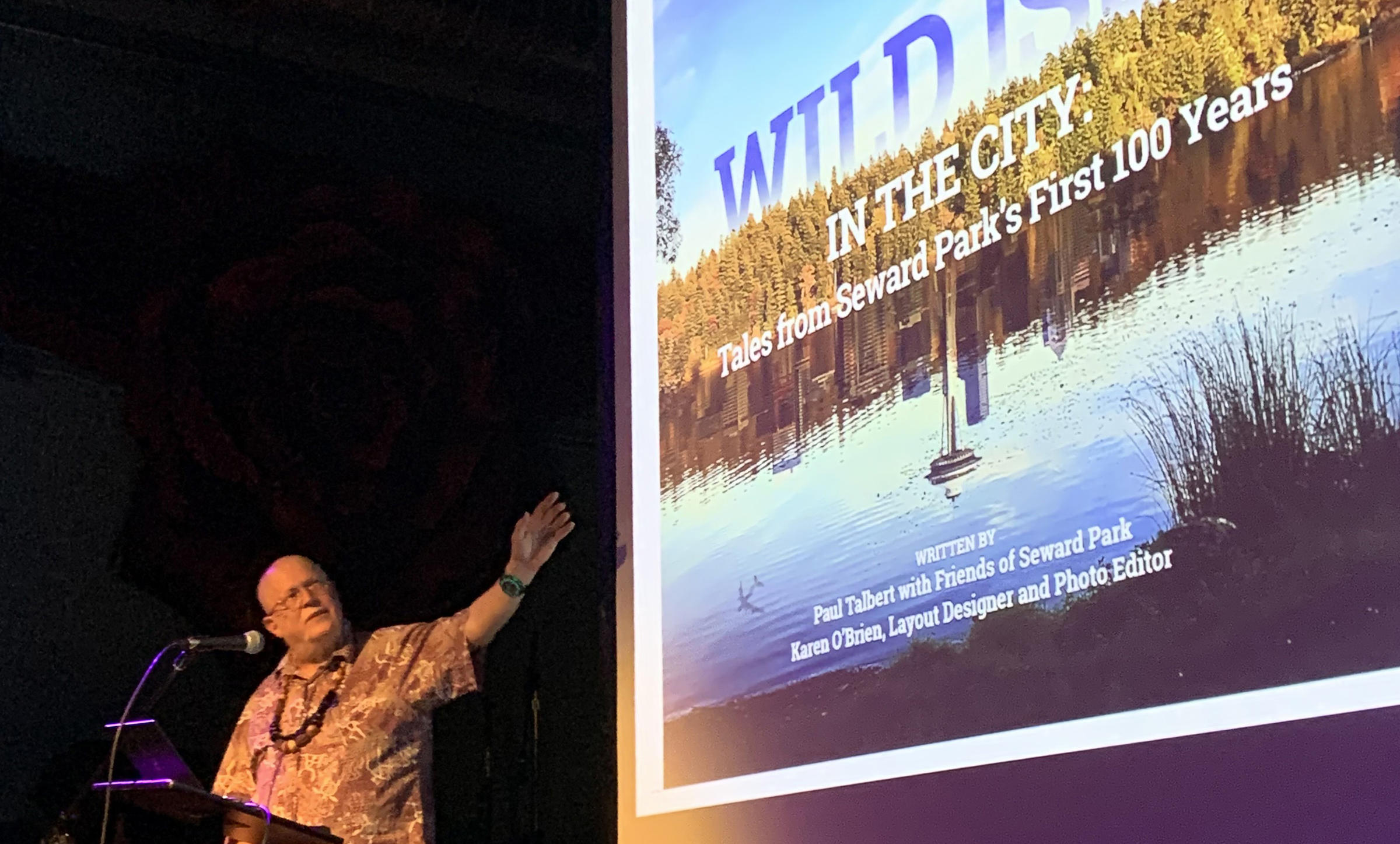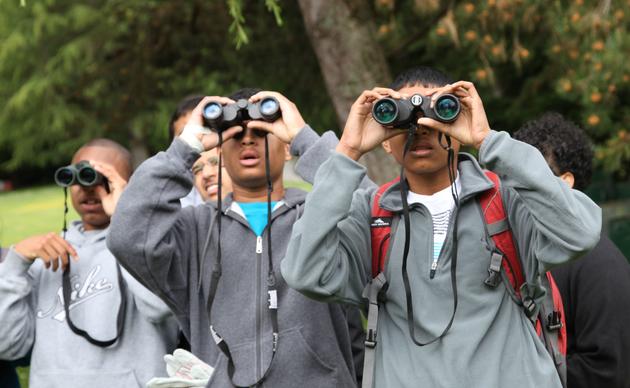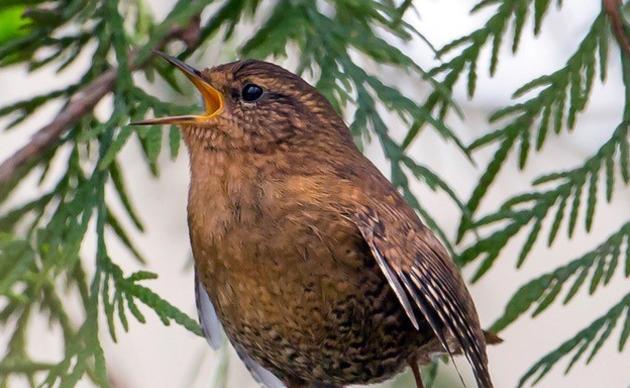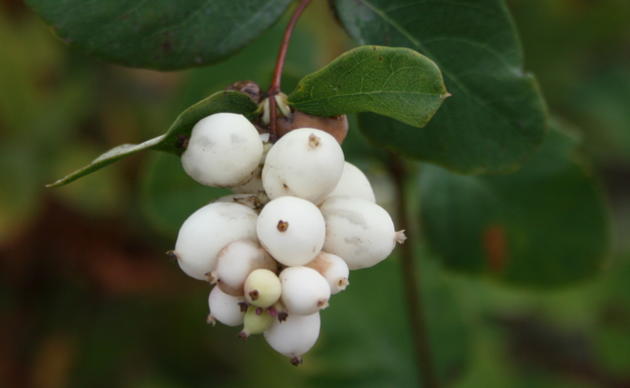Rewatch Your Favorite Presentations
So many authors, researchers, artists, and newsmakers have shared time with our community to broaden our knowledge and offer new perspectives. In case you missed them or would like to rewatch and share these programs, we've created this space to enjoy them again. The most recent program can be found here. Older programs can be found on our YouTube page. Enjoy!
The Naturalist's Notebook | Washington's Warblers
Each spring, numerous varieties of colorful warblers brighten our skies as they migrate to breeding grounds in the north. These birds make stopovers across the region, maybe even in a green space near you. Join online as naturalist Ed Dominguez as he takes inventory of the many species of warblers that make this remarkable journey each year.
Call of the City: Sharing Our City With Coyotes
Coyotes are an ever-present reminder of our connection with wildlife that inhabits many parts of our region. As we seek to understand their behaviors, we also ponder the role of coyotes in an area that seemingly grows less hospitable to them each year and stand witness to their wild nature that allows them to succeed, nonetheless.
To help provide a better understanding of our urban coyotes, we have assembled a panel whose expertise and experience dispel urban lore and provide years of research in its place.
Our panel includes:
- Katie Remine and Robert Long of the Woodland Park Zoo, and Mark Jordan of Seattle University, who lead the Seattle Urban Carnivore Project.
- Chris Anderson, Washington Department of Fish & Wildlife
- Sam Kreling, Seattle Coyote Study - University of Washington
- Ed Dominguez, Seward Park Audubon Center
- Janice Lee Clark
The Naturalist's Notebook | Arctic Visitors
All across our region, colorful birds can be seen on bodies of water large and small. From small rainwater ponds to lakes, to Puget Sound, birds that spend the summer in the far north have migrated south to overwinter with us. Join Lead Naturalist Ed Dominguez as he shows us these beautiful ducks, coots, and grebes that we call Arctic Visitors.
The Naturalist Notebook | The Knowledge of Corvids
Crows, ravens, and jays are among the smartest birds on earth; their intelligence is right up there with dolphins and whales…and us! Join lead Naturalist Ed Dominguez as we explore this fascinating family of birds: how to differentiate a crow from a raven; why are jays so raucous; and why magpies seem to change color. Meet the corvid family…smarter than your average birds.
Eric Scigliano | The Big Thaw
Permafrost is permanently frozen ground that lies under tundra and boreal forests across our northern regions?-covers more than 12 percent of the earth's landmass. It is also a vast store of ancient carbon, more than four times the quantity found in all of today's forests.
Eric Scigliano is the author of 'The Big Thaw.' Eric is a journalist and author with a longtime interest in climate change, the Arctic, and the alarming intersection between the two. He has been a science writer at the University of Washington and a staff writer and editor at several newspapers and magazines and has written for National Geographic, New Scientist, Discover, Harper's, Technology Review, and many other national publications.
Eric will join us at The Royal Room as reveals what the melting permafrost means to our health, our climate, and to the people who have called these landscapes home.
David B. Williams | Homewaters
David B. Williams shares insights on the unique ecology of Puget Sound from his book 'Homewaters.' The Sound possesses the features of both a fjord and an estuary and is a system that has nurtured human and non-human species for thousands of years. Below the surface, there are sunken forests and clams that live for over 150 years. But the waters are changing. In the Seward Park Audubon Center’s return to Columbia City’s Royal Room, David takes the stage to reveal the remarkable nature of the sound and its inhabitants and his perspective of how we affect the Sound, and the Sound affects us.
The Naturalist's Notebook | Native Plants and Bird Habitat
Seward Park Audubon Lead Naturalist Ed Dominguez presents the relationship between native birds and plants. Birds and native plants have been coevolving for the last 12,000 years. Planting with natives and removing invasive species is very beneficial to our birds. Find out how and when to do it safely with minimal impact on nesting birds. Ed will discuss best practices for establishing and maintaining green spaces to enhance bird habitat.
The Naturalist Notebook | Warblers
Join naturalist Ed Dominguez as he takes inventory of the many species of Warblers that brighten our skies each year as they migrate to breeding grounds in the north.
Paul Talbert | Wild Isle: From Wilderness To Park
From the Friends of Seward book ‘Wild Isle’, Paul Talbert presents the compelling chapter that looks at the 'The Lake People', who originally inhabited this area, and takes us through the people and actions that lead to the creation of Seattle's Seward Park. Joined by writer, translator, and passionate Seward Park advocate Wendy Call, this evening will provide a rich diagnosis of a memorable period in the park's evolution.
Amir Sheikh | The Waterlines Project with David B. Williams
Seattle is one of the most dramatically engineered cities in the United States. Shaped by natural and human forces, every location where the waters and land meet holds the stories of Seattle’s development. Our Seattle waterlines echo geologic episodes and political decisions made from the time of the glacial retreat to current development projects.
Amir Sheikh co-led a Burke Museum effort to reveal the ancient ghost landscapes of Seattle. This effort called The Waterlines Project has resulted in an immersive map that chronicles major events and projects that reshaped our landscape along with other endeavors such as collaborative site-specific art installations, museum exhibits, and various visualizations to reveal the hidden environmental and urban histories of our city.
Amir Sheikh is a transdisciplinary urban environmental researcher, curator, and collaboration builder. He currently consults for a variety of cultural landscape and spatial storytelling projects. Previously, at the University of Washington, he contributed to a range of environmental modeling and urban planning projects from hyper-local scales to global development contexts, regional historical ecology and landscape history research, and the development of place-based curriculum bridging the environmental sciences, social sciences, and the humanities.
Join us as Amir Sheikh presents the workings of The Waterline Project, followed by his live conversation with esteemed natural history writer David B. Willams. David also served as a collaborator for The Waterlines Project. A question and answer period will follow. This event is free and open to the public.
Amir shared his thoughts on two videos from the Burke Museum: Djidjila'letch to Pioneer Square: From Native village to Seattle metropolis, Duwamish Meanders, and 20,000 Years in Puget Sound. They offer additional insights into our city's geography.
Green Seattle Days Virtual Bird Walk
Join Seward Park Audubon Center as we take you to four birding spots across Seattle. We'll be looking and listening for our resident birds and welcoming the birds who make their winter home in the Puget Sound region. Four great birders will bring you live bird activity from Discovery Park, Meadowbrook Pond, the Union Bay Natural Area, and Seward Park. Also joining us in the field on Veterans Day is Ryan Mielcarek of Veteran Rites. This organization supports veterans find deep healing in the wilderness and give back to nature through reforestation activities.
Leard more about the Green Seattle Project
Learn more about Veterans Rites
Join Audubon Washington's 2020 Advocacy Day
Learn more about BIrdability
Visit Ed Dominguez's Seattle Nature Blog
Learn more about Feminist Bird Club Seattle
Learn more about SheBirds and Roniq
Buzz | Thor Hanson
Author and biologist Thor Hanson takes us on a journey that begins 125 million years ago, when a wasp first dared to feed pollen to its young. From honeybees and bumbles to lesser-known diggers, miners, leafcutters, and masons, bees have long been central to our harvests, our mythologies, and our very existence. They’ve given us sweetness and light, the beauty of flowers, and as much as a third of the foodstuffs we eat. And, alarmingly, they are at risk of disappearing. As informative and enchanting as the waggle dance of a honeybee, Buzz shows us why all bees are wonders to celebrate and protect. Read this book and you’ll never overlook them again.
Finding Nature in Seattle's Parks | Linnea Westerlind
The people of Seattle have access to over 400 city parks. Included in this array of ball fields and playgrounds lie wonderful areas of peace and natural beauty. During this period marked with isolation and life disruptions, natural spaces can offer a therapeutic benefit. Linnea Westerlind is the author of 'Discovering Seattle Parks.' As part of Seward Park Audubon Center's lecture series, Linnea will share her insights on places within our park system that help us reconnect with the natural world and invigorate our senses. The presentation is hosted by Todd Burley of Seattle Park and Audubon Washington.
Seattle's Tree Canopy
An urban tree canopy is made up of the leaves, branches, and stems of our trees that obscure the view of the ground from above. This system of trees reduces air pollution, lowers the City’s temperature, and provides beauty and wildlife habitat in our neighborhoods. The evening was moderated by Seattle Times writer Lynda Mapes and featured a panel including Woody Wheeler (Conservation Catalyst), Maria Batayola (Beacon Hill Council), June Bluespruce, Deb Heiden (Seattle Audubon Society), and David Moehring (UW - Bothell). They provided the current state of Seattle’s tree canopy and the goals for canopy coverage.
Seattle Urban Carnivore Project | Wildlife in Seattle
Woodland Park Zoo and Seattle University have launched a new project to explore how mammalian carnivores, such as coyotes, foxes, raccoons, bobcats, and even cougars and bears live and interact with people across urban and suburban areas in the Seattle region. Increasing contact between humans and carnivores potentially leads to more human-carnivore interactions and increased concerns about risks to humans, whether real or perceived. The continued survival of urban carnivore populations, as well as a sense of security for the public, requires an increased understanding of and coexistence with these species. Katie Remine (Woodland Park Zoo) and Mark Jordan (Seattle University) share insights from their research on our urban carnivores.
J.R. Harris | Way Out There
It all began in 1966 when, as a young New Yorker, he impulsively drives his VW Beetle across the country to the very end of the northernmost road in Alaska, searching for an answer to a simple question: What is it like to be way out there? His book 'Way Out There' is an account of his exploits while backpacking in some of the most rugged and remote places on earth. After more than a half-century of wilderness travel, he has plenty of tales to tell. J.R.'s stories are, at times, informative, humorous, tragic, unusual, and uplifting. He is an audaciously inquisitive guy who revels in exploring not just the edges of the world, but also the edges of his comfort zone.
J.R. joined us on July 30 to share what he's learned from his treks to some of the planet's most remote locations.
Lila Westreich | Mason Bees
Of the hundreds of native Northwest bee species, mason bees are some of the hardest working, sting-free pollinators we can bring into our backyards. Even though they do not produce honey, mason bees are more efficient as pollinators when compared to domestic honey bees. Lila Westreich, a Ph.D. candidate at the University of Washington, will share research that explores foraging trends of native bees in urban environments through genetic analysis.
Lila joined us July 16 for Science, Nature, and a Biscuit. Please enjoy Lila's presentation!
How you can help, right now
Get Involved
We rely on the talents of our volunteers to promote the efforts of the Center. Whether you're a budding naturalist or an organized decision-maker, we need you!
Get Native
Incorporating native plants into your yard or balcony garden provides important habitat for birds and promotes biodiversity.





